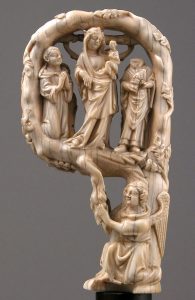Chapter Two – Myth & Metaphor
Andy Gurevich
The Greeks believed human thought functioned through two separate avenues, Logos and Mythos.

Logos is the analytical, logical method for dealing with the information and complexity of the world. It is governed by “rules” such as we still use in arguments and more formal logical exercises.
Then there is Mythos which follows our basic definition of myth: a collection of stories and beliefs held in common by a group of people. Unlike Logos, Mythos deals with non-logical, non-concrete, non-linear aspects of the world and our psyches. There are not rules governing how we interpret myths as they often deal with those things outside the realm of human consciousness and understanding.
The way that we can attempt to explain the unexplainable, those things beyond the world of Logos, is through metaphor. It takes a little work to wrap our heads around this concept, but it is important in helping us understand how to interpret the meaning of the myths. This idea of metaphor is not without controversy; it encourages us to view myths (and religion) in a different way. I ask you to read and consider before you judge.
Let’s start with a simple definition of metaphor: it is a comparison between two different things without using the words “like” or “as.” Simple, right? Maybe not so simple. Here is a comparison using like or as:
My love is like a red, red rose.
This clearly states a comparison, but let’s look at it as a metaphor:
My love is a red, red rose.
Makes a difference, doesn’t it? What the metaphor does is invite us to take the statement literally; we sometimes miss the idea of a comparison.
Let’s look at another metaphor:
He is such a snake in the grass.
This we know not to take literally. The metaphor suggests a comparison between the person and the qualities or attributes we associate with snakes (evil, dangerous, slimy). Furthermore, we know that not all snakes are dangerous, and they are evil only because we are using the snake as a metaphor. The snake’s association with evil is cultural. (More about snakes in the future.) So our metaphor—he is a snake—invites us to attach various ideas about the man through associating him with ideas we have about snakes, whether they are accurate or not.
We use metaphors every day to describe our feelings (I’m feeling blue) our troubles (My life is a train wreck) our happiness (I’m on cloud 9). Our dream are metaphors (dreams of flying, being chased, demons). We too often take our metaphors literally.
Myths are metaphors. The whole myth is a method of trying to convey things we don’t understand in a way that we can begin to understand. How must it have felt, before science and technology, to look up at the night sky and try to explain all those points of light? Or how do you explain the phases of the moon and its disappearance for three days? Even with a “scientific understanding” of the world, myths help us to create narrative containers for the awe we feel at the very mystery of existence itself. And metaphors are the primary vehicles of myths.
The use of metaphor helped ancient cultures understand. They created pictures with the brightest stars and named them after their gods. The moon became the goddess, dying and being reborn, just like the crops in the spring. The metaphors tied humans to the earth and the gods; they were both a part of creation, and separate from the gods.
Have a look at a illuminating encounter the late mythologist Joseph Campbell had with a radio host about the concept of metaphor by clicking here.
So, to sum up the main points:

- Metaphors suggest comparisons, although they don’t explicitly state a comparison.
- Myths are metaphors.
- Metaphors can often reveal truths that are deeper and more lasting, but harder to unpack.
- We cannot take the metaphor (or the myth) literally and expect to understand its full symbolic value.
Now you are ready to read the myths:

